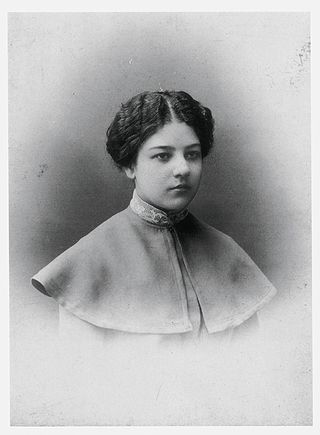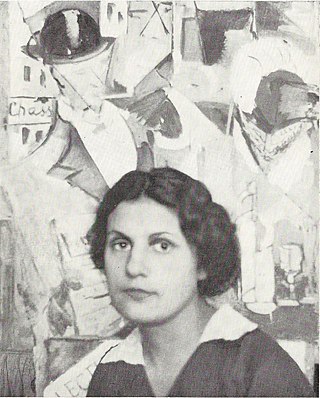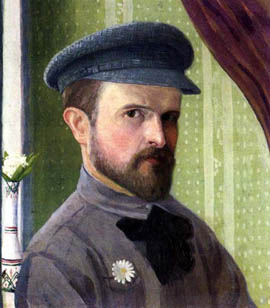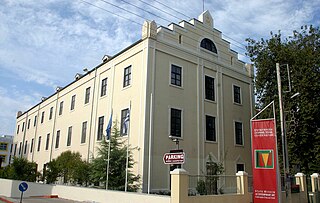
Kazimir Severinovich Malevich was a Russian avant-garde artist and art theorist, whose pioneering work and writing influenced the development of abstract art in the 20th century. Born in Kiev to an ethnic Polish family, his concept of Suprematism sought to develop a form of expression that moved as far as possible from the world of natural forms (objectivity) and subject matter in order to access "the supremacy of pure feeling" and spirituality. Malevich is also considered to be part of the Ukrainian avant-garde that was shaped by Ukrainian-born artists who worked first in Ukraine and later over a geographical span between Europe and America.

Suprematism is an early twentieth-century art movement focused on the fundamentals of geometry, painted in a limited range of colors. The term suprematism refers to an abstract art based upon "the supremacy of pure artistic feeling" rather than on visual depiction of objects.

Aleksandra Aleksandrovna Ekster, also known as Alexandra Exter, was a Russian and French painter and designer.

Lyubov Sergeyevna Popova was a Russian-Soviet avant-garde artist, painter and designer.

The Russian avant-garde was a large, influential wave of avant-garde modern art that flourished in the Russian Empire and the Soviet Union, approximately from 1890 to 1930—although some have placed its beginning as early as 1850 and its end as late as 1960. The term covers many separate, but inextricably related, art movements that flourished at the time; including Suprematism, Constructivism, Russian Futurism, Cubo-Futurism, Zaum, Imaginism, and Neo-primitivism. Many of the artists who were born, grew up or were active in what is now Belarus and Ukraine, are also classified in the Ukrainian avant-garde.

Cubo-Futurism was an art movement, developed within Russian Futurism, that arose in early 20th century Russian Empire, defined by its amalgamation of the artistic elements found in Italian Futurism and French Analytical Cubism. Cubo-Futurism was the main school of painting and sculpture practiced by the Russian Futurists. In 1913, the term ‘Cubo-Futurism’ first came to describe works from members of the poetry group ‘Hylaeans’, as they moved away from poetic Symbolism towards Futurism and zaum, the experimental “visual and sound poetry of Kruchenykh and Khlebninkov”. Later in the same year the concept and style of ‘Cubo-Futurism’ became synonymous with the works of artists within Ukrainian and Russian post-revolutionary avant-garde circles as they interrogated non-representational art through the fragmentation and displacement of traditional forms, lines, viewpoints, colours, and textures within their pieces. The impact of Cubo-Futurism was then felt within performance art societies, with Cubo-Futurist painters and poets collaborating on theatre, cinema, and ballet pieces that aimed to break theatre conventions through the use of nonsensical zaum poetry, emphasis on improvisation, and the encouragement of audience participation.

Nina Henrichovna Genke or Nina Henrichovna Genke-Meller, or Nina Henrichovna Henke-Meller was a Ukrainian-Russian avant-garde artist,, designer, graphic artist and scenographer.

Vadym Meller or Vadim Meller, was a Ukrainian Soviet painter, avant-garde Cubist, Constructivist and Expressionist artist, theatrical designer, book illustrator, and architect. In 1925 he was awarded a gold medal for the scenic design of the Berezil' theater in the Exposition Internationale des Arts Décoratifs et Industriels Modernes in Paris.

Olga Vladimirovna Rozanova was a Russian avant-garde artist painting in the styles of Suprematism, Neo-Primitivism, and Cubo-Futurism.

Ivan Albertovich Puni was a Russian avant-garde artist.

Nadezhda Andreevna Udaltsova was a Russian avant-garde artist, painter and teacher.
Supremus was a group of Russian avant-garde artists led by the "father" of Suprematism, Kazimir Malevich. It has been described as the first attempt to found the Russian avant-garde movement as an artistic entity within its own historical development.

Kseniya Boguslavskaya was a Russian avant-garde artist, poet and interior decorator. Her husband Ivan Puni was also a painter. She seems to be the originator of the Mavva featured in poems written by Velimir Khlebnikov.

Soyuz Molodyozhi was an artistic group and an art magazine of Russian avant-garde organized in 1910. There were more than 30 members of the group and most of other Russian avant-garde participated in their exhibitions.

Ivan Vasilievich Kliun, or Klyun, born Klyunkov was a Russian Avant-Garde painter, sculptor and art theorist, associated with the Suprematist movement.

MOMus Modern, in full MOMus–Museum of Modern Art–Costakis Collection, is a modern art museum based in Thessaloniki, Central Macedonia, Greece. It is housed in the renovated building of the old Lazariston Monastery in the Borough of Stavroupoli in west Thessaloniki. It was formerly known as the State Museum of Contemporary Art.

Universal War is an artist's book by Aleksei Kruchenykh published in Petrograd at the beginning of 1916. Despite being produced in an edition of 100 of which only 12 are known to survive, the book has become one of the most famous examples of Russian Futurist book production, and is considered a seminal example of avant-garde art from the beginning of the twentieth century.

Ukrainian avant-garde is the avant-garde movement in Ukrainian art from the end of 1890s to the middle of the 1930s along with associated artists in sculpture, painting, literature, cinema, theater, stage design, graphics, music, architecture. Some well-known Ukrainian avant-garde artists include: Kazimir Malevich, Alexander Archipenko, Vladimir Tatlin, Sonia Delaunay, Vasyl Yermylov, Alexander Bogomazov, Aleksandra Ekster, David Burliuk, Vadym Meller, and Anatol Petrytsky. All were closely connected to the Ukrainian cities of Kyiv, Kharkiv, Lviv, and Odesa by birth, education, language, national traditions or identity. Since it originated when Ukaine was part of the Russian Empire, Ukrainian avant-garde has been commonly lumped by critics into the Russian avant-garde movement.

The Last Futurist Exhibition of Paintings 0,10 was an exhibition presented by the Dobychina Art Bureau at Marsovo Pole, Petrograd, from 19 December 1915 to 17 January 1916. The exhibition was important in inaugurating a form of non-objective art called Suprematism, introducing a daring visual vernacular composed of geometric forms of varying colour, and in signifying the end of Russia's previous leading art movement, Cubo-Futurism, hence the exhibition's full name. The sort of geometric abstraction relating to Suprematism was distinct in the apparent kinetic motion and angular shapes of its elements.